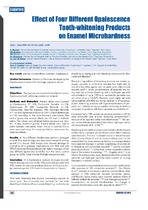Effect of four different Opalescence tooth-whitening products on enamel microhardness
Date
2008Author
Majeed, Abdul
Grobler, Sias Renier
Moola, Mohamad H.
Rossouw, Roelof
van Wyk Kotze, Theuns
Metadata
Show full item recordAbstract
OBJECTIVES: The purpose was to evaluate the effect of various Opalescence tooth-whitening products on enamel.
METHODS AND MATERIALS:
Enamel blocks were exposed to Opalescence PF 10% Carbamide Peroxide (n = 10), Opalescence PF 20% Carbamide Peroxide (n = 10), Opalescence Trèswhite Supreme 10% Hydrogen Peroxide (n = 10) and Opalescence Quick PF 45% Carbamide Peroxide (n = 10) according to the manufacturer's instructions. The control group was enamel blocks (n = 10) kept in artificial saliva. The values were obtained before exposure and after the 14-days treatment period. Enamel blocks were kept in saliva between treatments. Indent marks on enamel blocks were examined using the scanning electron microscope for treatment effects.
RESULTS:
All four different Opalescence products damaged enamel. The most damage was done when treated for a long period (112 hours). SEM images also showed damage to enamel by all 4 products. Opalescence with 10% and with 20% Carbamide Peroxide showed the highest damage, which also differed significantly (p < 0.05) from the saliva control group (p < 0.05; Tukey-Kramer Multiple comparison test).
CONCLUSION:
All 4 Opalescence products damaged enamel. Higher damage was done by the 10% carbamide peroxide and 20% carbamide peroxide products because of the much longer exposure period (112 hours in comparison to 7 hours).

